Abstract
Health risk analysis needs to apply newer developments in the understanding of the underlying mechanisms of the carcinogenic process which has allowed for the classification of chemical carcinogens into those that damage genetic material directly (genotoxic carcinogens) and those that operate by indirect or epigenetic mechanisms. We propose a systematic decision point approach for detecting and evaluating substances for carcinogenic risk. This approach recognizes that genotoxic and epigenetic agents operate by different mechanisms and distinguishes between these two categories of carcinogens primarily on the basis of results in a battery of short-term tests that includes systems which reliably detect genotoxic carcinogens and others which may respond to epigenetic agents. Genotoxic carcinogens at very low dosages may have practical, effective threshold no-effect levels, but, nevertheless, because of their mechanism of action they are regarded as a qualitative hazard. The action of epigenetic agents of the promoter class is highly dose-dependent and reversible, and thus, a distinctively different health risk analysis is required for these agents to take account of their quantitatively lesser hazard.
Full text
PDF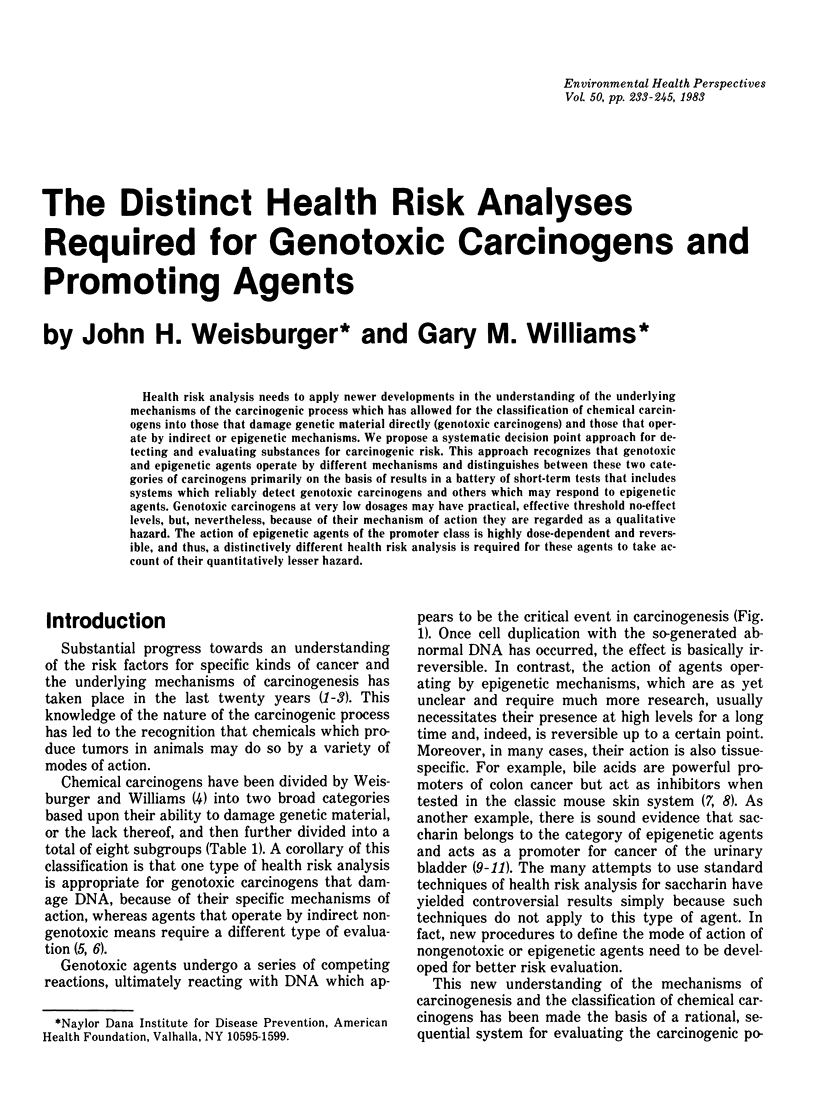

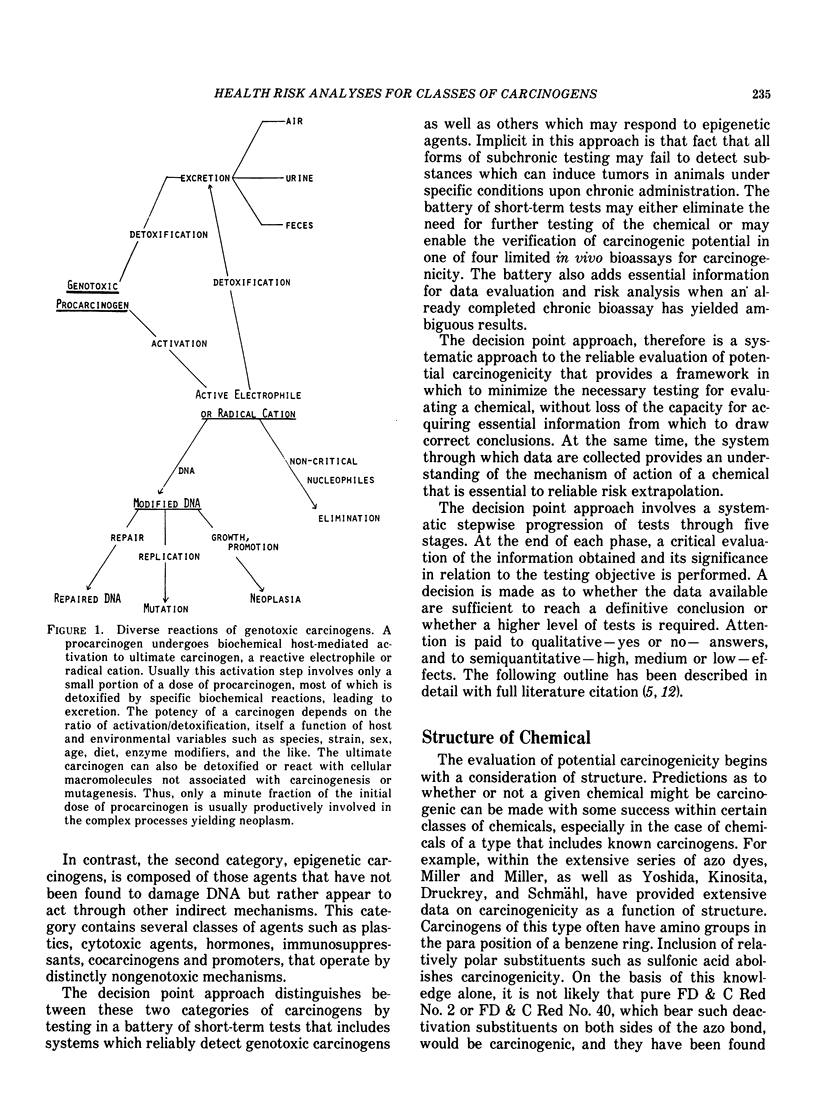
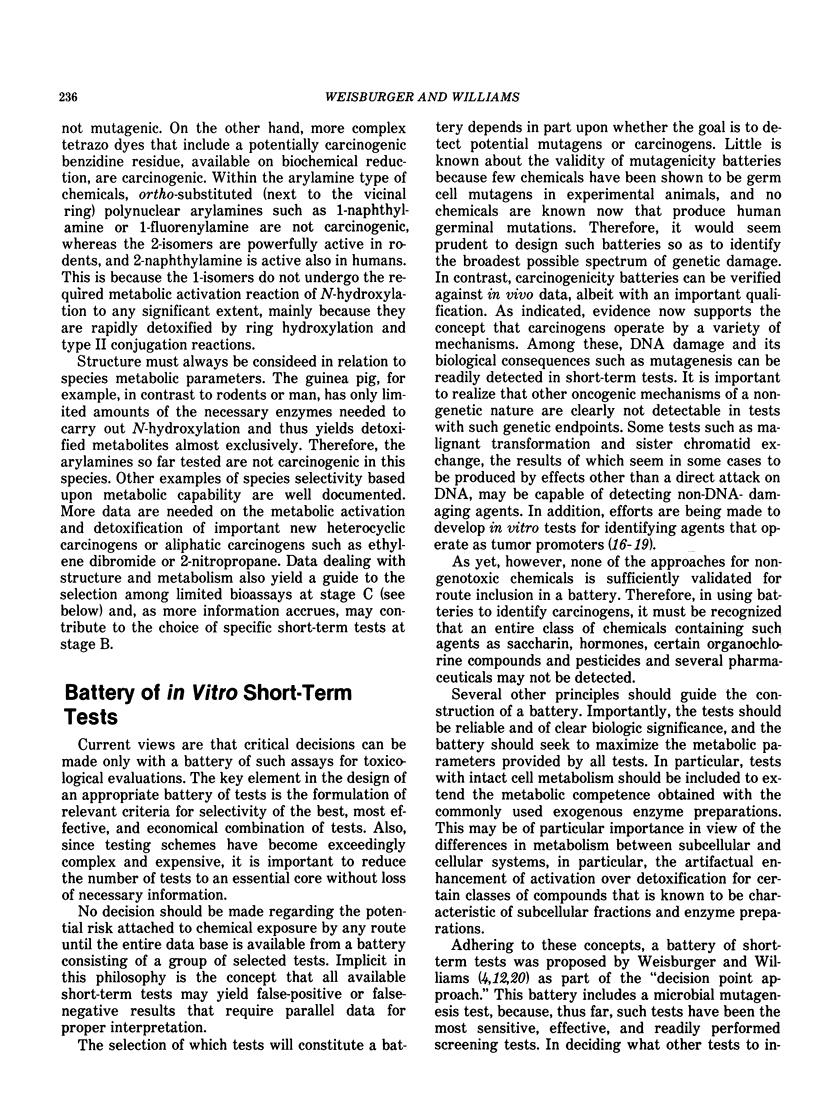
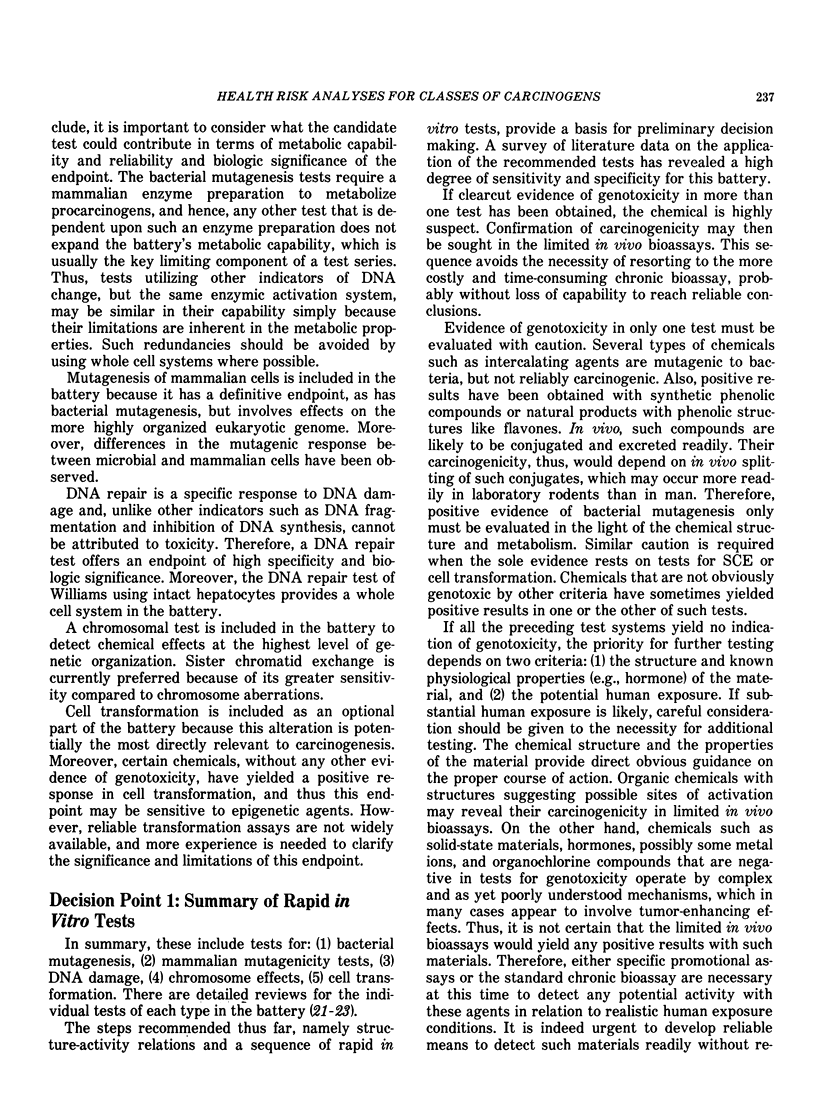






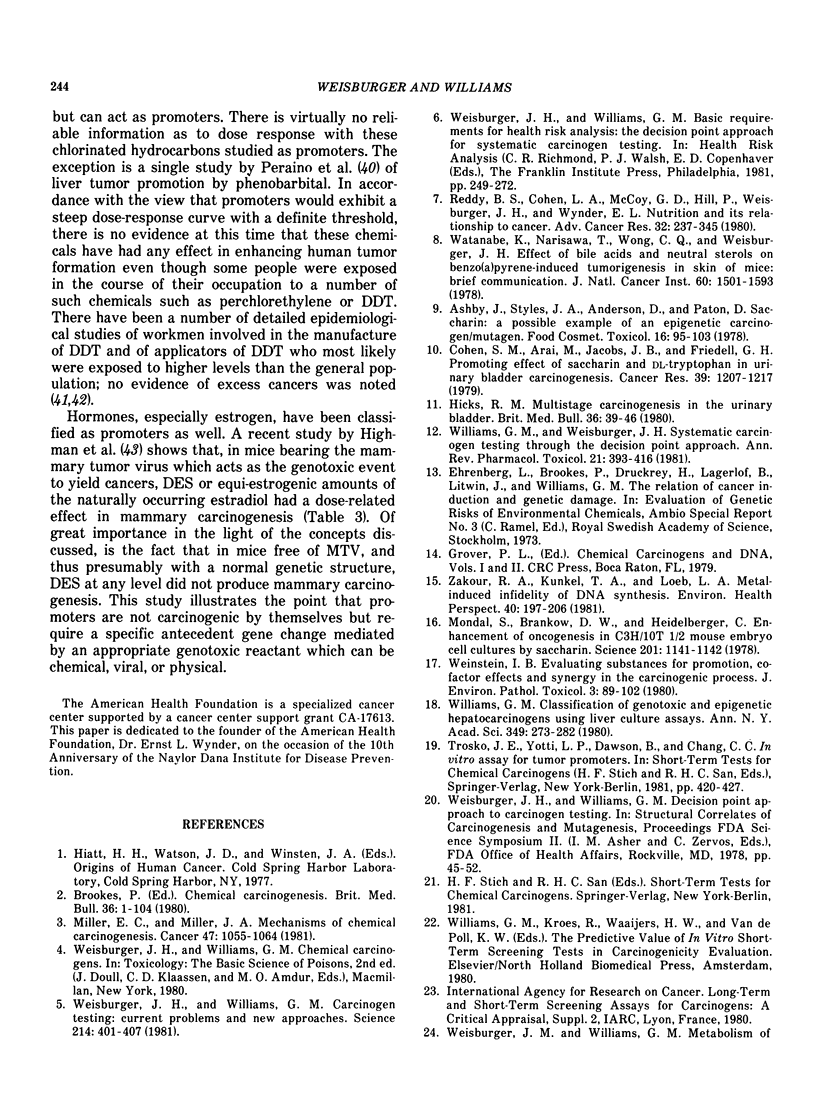

Selected References
These references are in PubMed. This may not be the complete list of references from this article.
- Ashby J., Styles J. A., Anderson D., Paton D. Saccharin: an epigenetic carcinogen/mutagen? Food Cosmet Toxicol. 1978 Apr;16(2):95–103. doi: 10.1016/s0015-6264(78)80187-4. [DOI] [PubMed] [Google Scholar]
- Bross I. D. Bladder cancer and artificial sweeteners: a methodological issue. Science. 1980 Oct;210(4468):447–448. doi: 10.1126/science.7433987. [DOI] [PubMed] [Google Scholar]
- Cohen S. M., Arai M., Jacobs J. B., Friedell G. H. Promoting effect of saccharin and DL-tryptophan in urinary bladder carcinogenesis. Cancer Res. 1979 Apr;39(4):1207–1217. [PubMed] [Google Scholar]
- Cornfield J. Carcinogenic risk assessment. Science. 1977 Nov 18;198(4318):693–699. doi: 10.1126/science.910152. [DOI] [PubMed] [Google Scholar]
- Deichmann W. B., MacDonald W. E. Organochlorine pesticides and liver cancer deaths in the United States, 1930--1972. Ecotoxicol Environ Saf. 1977 Jun;1(1):89–110. doi: 10.1016/0147-6513(77)90018-5. [DOI] [PubMed] [Google Scholar]
- Doll R., Peto R. The causes of cancer: quantitative estimates of avoidable risks of cancer in the United States today. J Natl Cancer Inst. 1981 Jun;66(6):1191–1308. [PubMed] [Google Scholar]
- Hayes W. J., Jr, Dale W. E., Pirkle C. I. Evidence of safety of long-term, high, oral doses of DDT for man. Arch Environ Health. 1971 Jan;22(1):119–135. doi: 10.1080/00039896.1971.10665822. [DOI] [PubMed] [Google Scholar]
- Hicks R. M. Multistage carcinogenesis in the urinary bladder. Br Med Bull. 1980 Jan;36(1):39–46. doi: 10.1093/oxfordjournals.bmb.a071611. [DOI] [PubMed] [Google Scholar]
- Higginson J. Proportion of cancers due to occupation. Prev Med. 1980 Mar;9(2):180–188. doi: 10.1016/0091-7435(80)90073-0. [DOI] [PubMed] [Google Scholar]
- MANTEL N., BRYAN W. R. "Safety" testing of carcinogenic agents. J Natl Cancer Inst. 1961 Aug;27:455–470. [PubMed] [Google Scholar]
- Miller E. C., Miller J. A. Mechanisms of chemical carcinogenesis. Cancer. 1981 Mar 1;47(5 Suppl):1055–1064. doi: 10.1002/1097-0142(19810301)47:5+<1055::aid-cncr2820471302>3.0.co;2-3. [DOI] [PubMed] [Google Scholar]
- Mondal S., Brankow D. W., Heidelberger C. Enhancement of oncogenesis in C3H/10T1/2 mouse embryo cell cultures by saccharin. Science. 1978 Sep 22;201(4361):1141–1142. doi: 10.1126/science.684434. [DOI] [PubMed] [Google Scholar]
- Nakanishi K., Hagiwara A., Shibata M., Imaida K., Tatematsu M., Ito N. Dose response of saccharin in induction of urinary bladder hyperplasias in Fischer 344 rats pretreated with N-butyl-N-(4-hydroxybutyl)nitrosamine. J Natl Cancer Inst. 1980 Nov;65(5):1005–1010. [PubMed] [Google Scholar]
- Reddy B. S., Cohen L. A., McCoy G. D., Hill P., Weisburger J. H., Wynder E. L. Nutrition and its relationship to cancer. Adv Cancer Res. 1980;32:237–345. doi: 10.1016/s0065-230x(08)60363-2. [DOI] [PubMed] [Google Scholar]
- Watanabe K., Narisawa T., Wong C. Q., Weisburger J. H. Effect of bile acids and neutral sterols on benzo[a]pyrene-induced tumorigenesis in skin of mice. J Natl Cancer Inst. 1978 Jun;60(6):1501–1503. doi: 10.1093/jnci/60.6.1501. [DOI] [PubMed] [Google Scholar]
- Weinstein I. B. Evaluating substances for promotion, cofactor effects and synergy in the carcinogenic process. J Environ Pathol Toxicol. 1980 Mar;3(4 Spec No):89–101. [PubMed] [Google Scholar]
- Weisburger J. H., Horn C. Nutrition and cancer: mechanisms of genotoxic and epigenetic carcinogens in nutritional carcinogenesis. Bull N Y Acad Med. 1982 Apr;58(3):296–312. [PMC free article] [PubMed] [Google Scholar]
- Weisburger J. H., Williams G. M. Carcinogen testing: current problems and new approaches. Science. 1981 Oct 23;214(4519):401–407. doi: 10.1126/science.7291981. [DOI] [PubMed] [Google Scholar]
- Williams G. M. Classification of genotoxic and epigenetic hepatocarcinogens using liver culture assays. Ann N Y Acad Sci. 1980;349:273–282. doi: 10.1111/j.1749-6632.1980.tb29532.x. [DOI] [PubMed] [Google Scholar]
- Williams G. M. Liver carcinogenesis: the role for some chemicals of an epigenetic mechanism of liver-tumour promotion involving modification of the cell membrane. Food Cosmet Toxicol. 1981 Oct;19(5):577–583. doi: 10.1016/0015-6264(81)90508-3. [DOI] [PubMed] [Google Scholar]
- Williams G. M., Weisburger J. H. Systematic carcinogen testing through the decision point approach. Annu Rev Pharmacol Toxicol. 1981;21:393–416. doi: 10.1146/annurev.pa.21.040181.002141. [DOI] [PubMed] [Google Scholar]
- Zakour R. A., Kunkel T. A., Loeb L. A. Metal-induced infidelity of DNA synthesis. Environ Health Perspect. 1981 Aug;40:197–205. doi: 10.1289/ehp.8140197. [DOI] [PMC free article] [PubMed] [Google Scholar]


